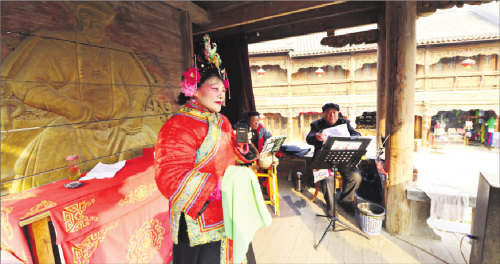
JU CHUANJIANG/CHINA DAILY
Folk artists perform Liuqin Opera at a traditional theater in Tai'erzhuang.
"The opening and flourishing of the Grand Canal not only turned Zaozhuang into a communication and economic hub during the Ming and Qing dynasties but also has left rich cultural legacies," Zaozhuang's cultural relics bureau director Shao Lei says.
The city now contains 406 intangible culture heritage items above the municipal level, including haozi, Liuqin Opera, storytelling in local dialect with drum accompaniment and Zaozhuang shadow puppetry.
"The canal caused the country's businesspeople to converge in the city, bringing diverse cultures and folk arts," Shao says.
The Zaozhuang government built a 10,000-square-meter national expo park for intangible cultural heritage in the ancient town of Tai'erzhuang alongside the canal.
Qing Emperor Qianlong once praised Tai'erzhuang as "the world's most affluent town". But it was destroyed during the War of Resistance against Japanese Aggression (1937-45).
Since 2009, 1.7 billion yuan ($278 million) has been allocated to restore the town to its former glory.
"The reappearance of traditional cultures and crafts is important to the town's reconstruction," says the town's management committee director Wang Guangjin.
Wang says 156 national- and provincial-level heritage items from across the nation are displayed in the park.
They include Beijiang clay sculptures, Luzhou oil-paper umbrellas and traditional New Year woodprint paintings from Shandong's Weifang.
Tourists can see how these handicrafts are created or try making their own.
Folk artists are also paid to perform in the town. Most are inheritors of centuries-old traditions at risk of vanishing.
Zhu Siquan was overjoyed when he was invited to the town to present Lunan dagu-storytelling in Zaozhuang dialect performed while beating a drum and two steel plates.
The performance art can be traced back to 400 years ago and was once very popular in areas around the canal, especially in northern China.
"About 40 years ago, dozens of people would gather in a teahouse every night and watch the show, which generally lasted two hours," says the 63-year-old, who began to learn the craft at age 13 and practiced it for almost half a century.
"The audience erupted into applause as soon as I stepped onstage. Some would come every day, since it usually took a month to finish a book."
Most of the stories are adopted from ancient Chinese literature, and told with rhymed lines and expressive body language.
Zhu lost most of his business 10 years ago and had to open a clothing shop to feed his family.
"I'm so glad I can find a new stage here where tourists can experience the ancient art's glory," Zhu says.
He earns 2,000 yuan a month.
Residents and farmers outside the town have organized more than 200 folk troupes. They've given over 6,000 performances to Zaozhuang's villagers and students, the municipal government reports.
"It's a good way to enrich our leisure and protect dying folk arts," says 62-year-old Yan Jingli, from a troupe in Yicheng district's Gushao township.
After retiring from the municipal opera troupe, Yan has volunteered to teach Liuqin Opera in a troupe of about 30 people ages 20 to 65.
"Most are nearby farmers," Yan says. "They're amateurs and can't perform very professionally. But it's a very good start."
